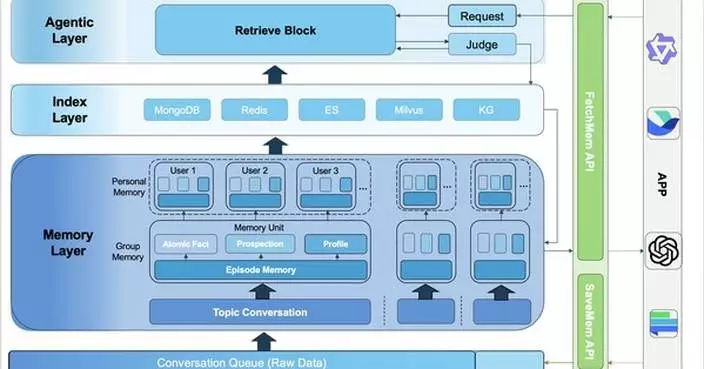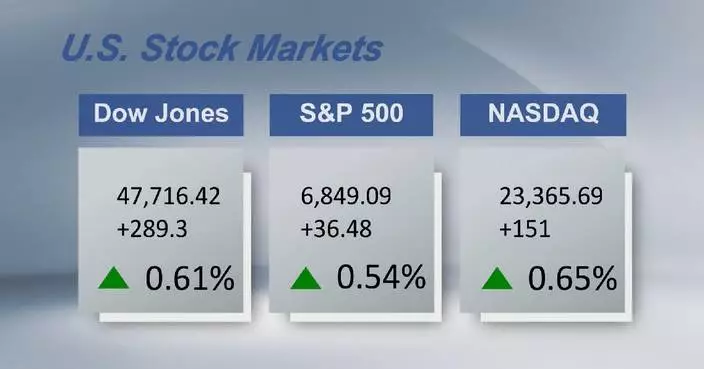Feature · News

China's grain output tops 714 mln tonnes in 2025

U.S. fighter jets enter Venezuelan airspace as tensions escalate

Army sergeant to face court-martial in Georgia base shooting that wounded 5

China's top political advisor meets Luxembourg's parliament president

China supports South Africa's participation in G20: spokesman

China stocks rise on policy support hopes: analyst

China outlines policy direction to boost growth quality, efficiency in 2026: experts

BP China Insight: Japanese media: Trump silent on China-Japan radar incident — what next?

Japanese militarism enemy of people worldwide: spokesman

BP China Insight: Amid the trade war, China's trade surplus first exceeds $1 trillion

Church Nativity scenes add zip ties, gas masks and ICE to protest immigration raids

Treason trial of South Sudan's suspended VP is further eroding peace deal, UN experts say

Man who opened fire outside his former Jewish school in Memphis avoids prison with guilty plea

Caitlin Clark says CBA negotiations are the 'biggest moment in the history of the WNBA'

Venezuela condemns U.S. oil tanker seizure as "piracy"

Navy investigation finds Osprey safety issues were allowed to grow for years
China outlines policy direction to boost growth quality, efficiency in 2026: experts

BP China Insight: Japanese media: Trump silent on China-Japan radar incident — what next?

Japanese militarism enemy of people worldwide: spokesman

BP China Insight: Amid the trade war, China's trade surplus first exceeds $1 trillion
China's grain output tops 714 mln tonnes in 2025
U.S. fighter jets enter Venezuelan airspace as tensions escalate

Army sergeant to face court-martial in Georgia base shooting that wounded 5
China's top political advisor meets Luxembourg's parliament president

China supports South Africa's participation in G20: spokesman
China stocks rise on policy support hopes: analyst

Church Nativity scenes add zip ties, gas masks and ICE to protest immigration raids

Treason trial of South Sudan's suspended VP is further eroding peace deal, UN experts say

Man who opened fire outside his former Jewish school in Memphis avoids prison with guilty plea

Caitlin Clark says CBA negotiations are the 'biggest moment in the history of the WNBA'
Venezuela condemns U.S. oil tanker seizure as "piracy"

Navy investigation finds Osprey safety issues were allowed to grow for years
Feature·Bloggers

【Bastille Commentary】Trump's Wake-Up Call: Quit Meddling in Hong Kong

【Mark Pinkstone】The return of Roach and his poisoned tongue

【What Say You?】UK Agitators Hijack Grief: The "Triplet" Protest Strategy

【Bastille Commentary】Tightening the Net on Subversive “Parliaments” Is Exactly the Point

【Bastille Commentary】The UK Is Truly Sneaky Towards Hong Kong Migrants

【Mao Paishou】Poll Shock: China’s Fan Base Surges—But There’s No Mystery Here

Gaza amputees struggle to rebuild lives as the enclave faces shortages of prosthetic limbs
- Historic rains and flooding trigger dramatic rescues in Washington state
- What to know about Kilmar Abrego Garcia's release from immigration custody
- Trump says he's sealed Thailand-Cambodia ceasefire, but fighting continues
- Speaker Johnson unveils health care plan as divided Republicans scramble for alternative
- Thai villagers stay behind to guard empty homes as border clashes force mass evacuations
- Democratic former Sen. Doug Jones launches campaign for Alabama governor
- Utah repeals ban on collective bargaining for teachers, firefighters and police unions
- Bolivian court orders ex-president jailed for 5 months on corruption charges
- LA Angels president testifies he wishes he'd known about drug use before pitcher's fatal overdose

China commemorates Nanjing Massacre victims in National Memorial Ceremony
- Only 24 survivors of Nanjing Massacre remain alive today
- China's national flag flies at half-mast to mourn Nanjing Massacre victims
- Senior Chinese legislator meets Portugal's PSD delegation
- China sees growth in social financing in first 11 months
- Avatar 3 marks story's culmination: director
- Analyst recaps Asian stock markets' Friday performance
- Beijing's Forbidden City blanketed in snow
- Volunteers help blind footballers at Games for Persons with Disabilities
- China firmly opposes illegal unilateral sanctions: spokesman

SmallRig and FamilyLens Launch Global Family Filmmaking Initiative at 3rd FamilyLens International Film Festival
- SEAX Global Acquires Major Stake in Interlink Telecom to Accelerate ASEAN Expansion
- HiTHIUM Launches Three Breakthrough Innovations at Its Third Eco-Day, Unlocking an Intelligent Future with Long-Duration Energy Storage
- M7 World Championship unveils first Opening Ceremony, tournament draw, and M7 Pass—elevates Indonesia on global stage
- New York is the 8th state found to have improperly issued commercial driver's licenses to immigrants
- Problems with commercial driver's licenses for immigrants found in 8 states so far
- AI Infrastructure Company EverMind Released EverMemOS, Responding to Profound Challenges in AI
- US accuses Rwanda of violating the peace deal as M23 rebels seize a key eastern Congo city
- A new federal report scrutinizes Puerto Rico's tax incentives luring wealthy Americans
- Introducing CASEKOO Rouge. The Gold Standard.

Humanoid robots take center stage at Silicon Valley summit, but skepticism remains
- Winter virus season so far is not too bad, but doctors worry about suffering to come
- Ford turns to stepped-up tech and cooperation with police to thwart F-150 pickup thieves
- A Chinese whistleblower now living in the US is being hunted by Beijing with help from US tech
- Appeals court backs contempt finding against Apple, but reopens a door for iPhone app fees
- Disney invests $1B in OpenAI in deal to bring characters like Mickey Mouse to Sora AI video tool
- These are the key AI players on the cover of Time's 'Architects of AI' magazine
- Open AI, Microsoft face lawsuit over ChatGPT's alleged role in Connecticut murder-suicide
- NASA loses contact with its Maven spacecraft orbiting Mars for the past decade
- Professor Youmin Xi honoured with University of Liverpool Fellowship

Hailee Steinfeld and NFL husband Josh Allen are expecting their first child
- Meet the Indigenous women behind Mexican President Claudia Sheinbaum's 'most stylish' looks
- Oscar winner Morricone’s lost opera debuts in Naples after 30 years
- Bestselling British writer Joanna Trollope dies at 82
- It feels good to be Jelly Roll. And now, he's ready to win a Grammy
- Photos show Ennio Morricone's opera 'Partenope' as it premieres in Naples
- A dance hall in Buenos Aires guarantees tango sessions with professional partners
- Director convicted of scamming $11M from Netflix and going on lavish spending spree
- Eurovision champion Nemo returns the winner's trophy to protest Israel's inclusion
- UNESCO gives a shout-out to Switzerland's yodeling by adding it to list of cultural heritage

James McDonald officially accepts LONGINES World’s Best Jockey award
- Guenther scores tiebreaking goal in 3rd period as Mammoth beat Kraken 5-3 to end three-game skid
- Blackhawks' Bedard injured on last-second faceoff, to miss game against Red Wings on Saturday
- Ja Morant has 21 points and 10 assists in return to Grizzlies lineup after 10-game absence
- Anthony Davis has 24 points and 14 rebounds to lead Mavericks past Nets 119-111
- Keyonte George scores a career-high 39 points as Jazz beat Grizzlies 130-126
- Mailloux, Luff get first goals of season as Blues beat rival Blackhawks 3-2
- With 24 points, Donovan Mitchell produces the highest-scoring 4th quarter of the NBA season so far
- Wild acquire star defenseman Quinn Hughes from the Canucks in a blockbuster NHL trade
- Karaban and Reed lift No. 5 UConn to 71-63 win over Texas in Huskies' final nonconference game

Former SCED Gregory So Remembered for Contributions to Hong Kong's Economic Development
- Interdepartmental Committee Updates Progress on Mosquito Control and Chikungunya Prevention at Tsing Yi Nature Trails
- Nine arrested in Hong Kong for unlawful drilling related to national security, police seize offensive weapons
- Task Force Enhances Mental Health Support for Tai Po Fire Victims and Families
- Two Passengers Sentenced for Importing Duty-Not-Paid Cigarettes, Highlighting Customs Enforcement Efforts
- Hong Kong Customs Seizes $8.9 Million in Drugs, Arrests Three in Major Trafficking Busts
- Government Announces Updates on Follow-up Work on Tai Po fire
- The Statement Issued on Behalf of the Chairman of the Independent Committee in Relation to the Tai Po Fire
- Independent Committee Formed to Investigate Wang Fuk Court Fire in Tai Po
- OFNAA Launches Saying NO to Objectionable Information Exhibitions to Promote Healthy Internet Use

Attempts to stop China's sci-tech development doomed to fail: former Singaporean diplomat
- U.S. stocks sink as AI concerns weigh on tech sector
- Crude futures settle lower
- U.S. dollar ticks up
- Thailand, Cambodia have agreed to cease all shooting effective Friday evening: Trump
- Russia highlights neutrality, denuclearization amid Ukraine-US divergence on peace plan
- Survivor of Japan's wartime sexual slavery, chemical attacks bravely shares story in CGTN documentary
- CGTN documentary reveals tragedies of Philippine "comfort women"
- British nationals involved in military operations against Russia: Lavrov
- Experts highlight policy coordination as key to China's quality-first economic strategy for 2026
Category · News

James McDonald officially accepts LONGINES World’s Best Jockey award

Gaza amputees struggle to rebuild lives as the enclave faces shortages of prosthetic limbs

Guenther scores tiebreaking goal in 3rd period as Mammoth beat Kraken 5-3 to end three-game skid

SmallRig and FamilyLens Launch Global Family Filmmaking Initiative at 3rd FamilyLens International Film Festival

Historic rains and flooding trigger dramatic rescues in Washington state

What to know about Kilmar Abrego Garcia's release from immigration custody

Former SCED Gregory So Remembered for Contributions to Hong Kong's Economic Development

Blackhawks' Bedard injured on last-second faceoff, to miss game against Red Wings on Saturday

Trump says he's sealed Thailand-Cambodia ceasefire, but fighting continues
Attempts to stop China's sci-tech development doomed to fail: former Singaporean diplomat

Ja Morant has 21 points and 10 assists in return to Grizzlies lineup after 10-game absence

Anthony Davis has 24 points and 14 rebounds to lead Mavericks past Nets 119-111

Keyonte George scores a career-high 39 points as Jazz beat Grizzlies 130-126

Mailloux, Luff get first goals of season as Blues beat rival Blackhawks 3-2

With 24 points, Donovan Mitchell produces the highest-scoring 4th quarter of the NBA season so far

SEAX Global Acquires Major Stake in Interlink Telecom to Accelerate ASEAN Expansion

Wild acquire star defenseman Quinn Hughes from the Canucks in a blockbuster NHL trade

Karaban and Reed lift No. 5 UConn to 71-63 win over Texas in Huskies' final nonconference game

HiTHIUM Launches Three Breakthrough Innovations at Its Third Eco-Day, Unlocking an Intelligent Future with Long-Duration Energy Storage

Speaker Johnson unveils health care plan as divided Republicans scramble for alternative

Thai villagers stay behind to guard empty homes as border clashes force mass evacuations
U.S. stocks sink as AI concerns weigh on tech sector

Democratic former Sen. Doug Jones launches campaign for Alabama governor
China commemorates Nanjing Massacre victims in National Memorial Ceremony

Embiid scores season-high 39 points to lead 76ers to 115-105 win against Pacers

M7 World Championship unveils first Opening Ceremony, tournament draw, and M7 Pass—elevates Indonesia on global stage
Only 24 survivors of Nanjing Massacre remain alive today

Mitchell scores 24 of his 48 points in the 4th quarter to rally Cavaliers past Wizards 130-126

Josh Giddey scores 26 points, Bulls hang on to beat Hornets 129-126 to snap 7-game losing streak

Pistons tie NBA record for scoring balance in 142-115 win over Hawks
Crude futures settle lower

Utah repeals ban on collective bargaining for teachers, firefighters and police unions
U.S. dollar ticks up

Bolivian court orders ex-president jailed for 5 months on corruption charges

Indiana QB Fernando Mendoza wins Maxwell and O'Brien awards with Heisman on deck

LA Angels president testifies he wishes he'd known about drug use before pitcher's fatal overdose

Cue the trumpets! Edwin Díaz lands in LA to start his new chapter with the champion Dodgers

New York is the 8th state found to have improperly issued commercial driver's licenses to immigrants
China's national flag flies at half-mast to mourn Nanjing Massacre victims

Record floods in Washington state trigger dramatic rescues and evacuations

Trump was unable to insult his way to victory in Indiana redistricting battle

US removes Brazilian Supreme Court justice and his wife from sanctions list

Problems with commercial driver's licenses for immigrants found in 8 states so far

Ohio State’s Caleb Downs Named 2025 Paycom Jim Thorpe Award Winner

Lakers' Austin Reaves to miss at least a week with a mild calf strain

Hailee Steinfeld and NFL husband Josh Allen are expecting their first child

AI Infrastructure Company EverMind Released EverMemOS, Responding to Profound Challenges in AI

The Latest: Thai and Cambodian leaders agree to renew ceasefire after deadly clashes, Trump says

Spurs' Victor Wembanyama set to return for NBA Cup semifinals vs. Thunder after 12-game absence

Right-hander Chase Lee acquired by Blue Jays from Tigers for minor league lefty Johan Simon

Dearica Hamby and Las Vegas Aces drop lawsuit over pregnancy discrimination

Justice Department sues 4 more states for access to detailed voter data

For the Thunder, the Cup is the trophy that got away. The Knicks, Spurs and Magic want it as well

Trump sued by preservationists seeking reviews and congressional approval for ballroom project

The 49ers host the Titans in search of their first 4-game winning streak since 2023

Canadian concerns growing over whether women's hockey team can defend Olympic title vs. US

Rare fresco of Jesus as the 'Good Shepherd' uncovered in Turkish town visited by the pope

US accuses Rwanda of violating the peace deal as M23 rebels seize a key eastern Congo city

Humanoid robots take center stage at Silicon Valley summit, but skepticism remains

Second WiresConnect Concludes with Consensus that AI Is Leveling the Commerce Playing Field in Fashion and Beauty

Meet the Indigenous women behind Mexican President Claudia Sheinbaum's 'most stylish' looks

Global players union advocates for rest periods to alleviate player workload in women's soccer

Undrafted rookie quarterback Brady Cook to make first NFL start for Jets against Jaguars

A new federal report scrutinizes Puerto Rico's tax incentives luring wealthy Americans

After Toronto Blue Jays reach World Series, team president Mark Shapiro gets new 5-year contract
Senior Chinese legislator meets Portugal's PSD delegation

Kenny Pickett to start for Raiders against Eagles with Geno Smith out

Štulić scores first Serie A goal to give Lecce a vital win over Pisa

Right-hander Michael Soroka and Arizona Diamondbacks finalize a $7.5 million, 1-year contract

Cowboys cling to playoff hopes as Vikings visit with focus on McCarthy's growth

Introducing CASEKOO Rouge. The Gold Standard.

Union Berlin beats Leipzig 3-1 in Bundesliga with second-half flurry

Piper Gilles and Paul Poirier try to put disappointment behind them ahead of Olympics

Caitlin Clark returns to court after injury-filled season, making USA Basketball senior team debut

King Charles III says his cancer treatment is being reduced as he promotes benefits of screening

Jurors are deliberating in murder trial of Brian Walshe, whose wife disappeared 2 years ago

KB Home Announces the Grand Opening of Two New Communities Within the Highly Desirable Crosswinds Master Plan in Morgan Hill, California

LS Cable & System Announces Additional Investment in Chesapeake, Virginia

O aplicativo New World: Chat criptografado e pagamentos globais para todos

Sherrone Moore charged with stalking, home invasion after being fired as Michigan football coach

Union Pacific Appoints Will to Board of Directors

Tumbling tech stocks drag Wall Street to its worst day in 3 weeks

Jaguars can reach double-digit wins for the second time since 2007 when they host the Jets

From troubled youth to NFL star: Garett Bolles' journey








































